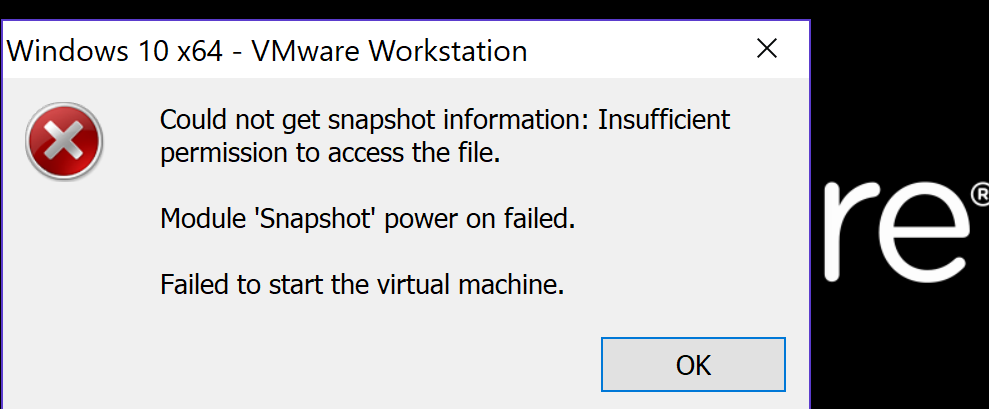Vmware Insufficient Permission To Access File
Usually, you give privileges to users by assigning permissions to ESXi host objects that are managed by a vCenter Server system. If you are using a standalone ESXi host, you can assign privileges directly.
- Failed to clone disk: Insufficient permission to access file (38). I tried from another server without netapp plug-in and all function well. Otherwise i try to copy vmdk from vmware vsphere client and i receive the follow error.
- Insufficient permission to access file This issue is usually observed in virtual machines located on NFS datastores. This issue may occur due to permissions issues on the NFS datastore. To resolve this issue, ensure that the host has the correct read/write permissions to access the NFS export.
حل مشكلة Vmware - insufficient permission.
Assigning Permissions to ESXi Hosts That Are Managed by vCenter Server
If your ESXi host is managed by a vCenter Server, perform management tasks through the vSphere Client.
Vmware Insufficient Permission To Access File Recovery
You can select the ESXi host object in the vCenter Server object hierarchy and assign the administrator role to a limited number of users. Those users can then perform direct management on the ESXi host. See Using Roles to Assign Privileges.
Best practice is to create at least one named user account, assign it full administrative privileges on the host, and use this account instead of the root account. Set a highly complex password for the root account and limit the use of the root account. Do not remove the root account.
Assigning Permissions to Standalone ESXi Hosts
You can add local users and define custom roles from the Management tab of the VMware Host Client. See the vSphere Single Host Management - VMware Host Client documentation.
For all versions of ESXi, you can see the list of predefined users in the /etc/passwd file.
The following roles are predefined.
- Read Only
- Allows a user to view objects associated with the ESXi host but not to make any changes to objects.
- Administrator
- Administrator role.
- No Access
- No access. This role is the default role. You can override the default role.
You can manage local users and groups and add local custom roles to an ESXi host using a VMware Host Client connected directly to the ESXi host. See the vSphere Single Host Management - VMware Host Client documentation.
Starting with vSphere 6.0, you can use ESXCLI account management commands for managing ESXi local user accounts. You can use ESXCLI permission management commands for setting or removing permissions on both Active Directory accounts (users and groups) and on ESXi local accounts (users only).
Predefined Privileges
If your environment does not include a vCenter Server system, the following users are predefined.
By default each ESXi host has a single root user account with the Administrator role. That root user account can be used for local administration and to connect the host to vCenter Server.
Assigning root user privileges can make it easier to break into an ESXi host because the name is already known. Having a common root account also makes it harder to match actions to users.
For better auditing, create individual accounts with Administrator privileges. Set a highly complex password for the root account and limit the use of the root account, for example, for use when adding a host to vCenter Server. Do not remove the root account. For more information about assigning permissions to a user for an ESXi host, see vSphere Single Host Management - VMware Host Client documentation.
 Best practice is to ensure that any account with the Administrator role on an
Best practice is to ensure that any account with the Administrator role on an  ESXi host is assigned to a specific user with a named account. Use ESXi
ESXi host is assigned to a specific user with a named account. Use ESXiVmware Insufficient Permission To Access File Ubuntu
Active Directory capabilities, which allow you to manage Active Directory credentials.Vmware Insufficient Permission To Access File System
The vCenter Server administrator can perform most of the same tasks on the host as the root user and also schedule tasks, work with templates, and so forth. However, the vCenter Server administrator cannot directly create, delete, or edit local users and groups for hosts. Only a user with Administrator privileges can perform these tasks directly on a host.
Vmware Insufficient Permission To Access File Location
Vmware Insufficient Permission To Access File Management
Vmware Insufficient Permission To Access File Type
This user acts as an agent for the direct console and cannot be modified or used by interactive users.